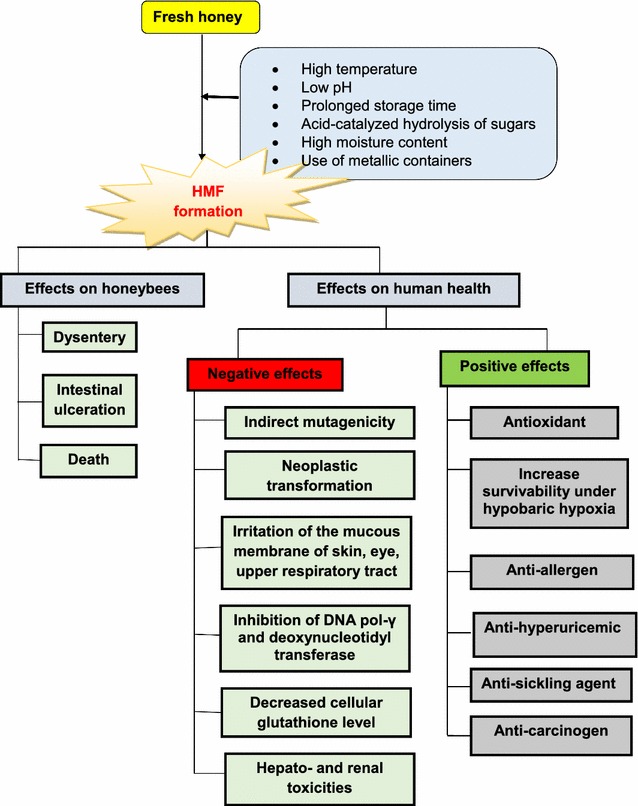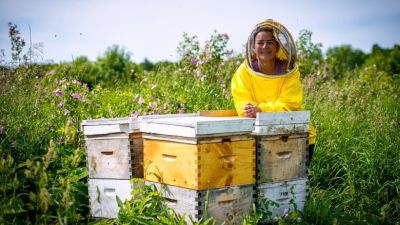It’s tasty and it’s healthy. Two reasons to make profit cheating on people who have not yet got used to verify and double verify the authenticity of everything, to always search for reviews before buying something, to always ask for a second opinion, to always doubt any news or any advertisement. Do you know what is HMF? Well, it’s an indicator of quality of honey. Fake honey, too processed honey or old honey.
Fakes are a general problem. You will find fake honey in the market, supermarket, online shops, and on the edge of roads. And not only expensive honey can be fake, any type of honey can be faked.
On 1st of August 2018, thetimes.co.uk was telling us that “Britain’s biggest health food retailer is to start testing jars of manuka honey before they go on sale, in the face of a plague of fake products flooding the market.” For this, Holland & Barratt were to send each and every sample to the laboratory. And guess what, it will be even more expensive.
Again. There were warnings all over. On news, on blogs, on TVs, people are warned about fake honey, especially manuka honey – as it is expensive. But do scammers stop? No. They don’t. They’ll never stop. Only become better. 🙁
Frauds are everywhere. It’s not about manuka honey, but about every other type. And not only in the UK.
In Malaysia for example, people have a culture of consuming this healthy product and greatly exceed European consumption. Which means they also produce a lot of honey. But this doesn’t stop them from still scamming the population.
Thecoverage.my was reporting in November 2017 that 80% of honey found in Malaysian markets are fake. 80% is a terribly large number. And authoritites warn population about the risk of getting sick instead of getting healthier.
The test results from their laboratories found that the artificial honey sold there was made out of sugar, starch, and corn flour — and all of them, when consumed in excess, could harm consumers’ health, especially diabetics.
Too much HMF. What does this mean?
Principal research officer of Malaysian Agricultural Research and Development Institute (MARDI), Dr. Suri Roowi found that five samples of honey bought from different merchants contained a high amount of hydroxymethylfurfural (HMF). And some others…”We found that some samples have no nutritional values or source of honey in them, confirming that they are all synthetic” said Roowi.
HMF, on its long name 5-hydroxymethylfurfural, is an organic compound formed from reducing sugars in honey. It also appears in various processed foods in acidic environments, when they are heated, through the Maillard reaction. In addition to processing, storage conditions affect the formation HMF, and hence, HMF has become a suitable indicator of honey quality.
What is the normal level of HMF?
Depending on the floral source, fresh natural honey can have varying levels of HMF. In the hive honey would normally be below 1 mg/kg, but this number will soon start to rise when the temperature rises above 20°C. In a beehive, temperature can rise to a little over 40°C during summer months (when the main honey crop is in progress).
Fresh extracted honey should have a HMF level below 10 mg/kg.
Processed honey should have a HMF level below 40 mg/kg.
Levels higher than this may indicate excessive heating during the extraction process or storing at high temperature for long periods of time. HMF is easily formed at low temperatures in the presence of low-pH or acidic conditions, while high temperature and long storage duration increase its concentration to a large extent.
In 2007 Kandolf showed that the analysis of honey stored for one year at a temperature of about 20° Celsius, show an increase in HMF content of 16 mg / kg of honey per year, or 1 to 2 mg / kg per month.
In 2013 Moniruzzaman et al.reported in a study that the mean HMF concentration in Malaysian honeys stored for 2 months at 4–5 °C is 35.98 mg/kg. But in 2010 Khalil et al. found that HMF concentrations in Malaysian honey stored at 25–30 °C for more than a year could reach very high levels of 118.47 to even 1139.95 mg/kg.
What makes HMF level rise?
In addition to heating, several other factors influence the formation of HMF in honey, such as honey’s physicochemical properties:
· pH,
· free acid content,
· total acidity,
· lactone content and mineral content,
· water activity (aw),
· the use of metallic containers
· thermal and photochemical stress.
The rate of HMF formation is also dependent on the fructose:glucose ratio and the type of sugars formed because it has been reported that at pH 4.6, fructose has five times more reactivity than glucose, and a high fructose:glucose ratio will accelerate the reaction. It was also showed that temperature and duration of heat treatment may both affect HMF formation in honey samples.
HMF is an indicator of quality for honey.

Today HMF is used as an indicator of heating or storage at elevated temperatures.
Since 1908 HMF was also used as an indicator of the adulteration of honey with invert syrups (syrups of glucose and fructose). HMF is created when sucrose (sugar) is heated with a food acid.
So HMF is used to indicated 2 things:
– adulteration of honey with sugar (usually with levels greater than 100 mg/kg
– heating and bad storage conditions.
Nectar honey and honeydew honey processed at 95 °C for 90 min and 90 °C for 75 min showed HMF levels lower than 40 mg/kg (international requirement).
What other products contain HMF?
HMF is also present in dried fruits (> 1 g/kg), products containing caramel, instant coffee (up to 6.2 g/kg), apple juice, citrus juices, beer, brandy, milk, breakfast cereal, baked foods, and tomato products. HMF is also released from sugar and carbohydrates after home cooking.
The other different food products that we consume daily, such as: bakery goods, milk, fruit juice, cereals, coffee, chocolate, soft drinks, vinegar, wine, nuts and grilled meat are all undergoing thermal treatments prior to consumption, such as boiling, baking, extrusion cooking, roasting, pasteurization and other processing. During thermal processing and preservation, the Maillard reaction or non-enzymatic browning may also occur, where HMF is a common product whose extent of formation depends on the processing and preservation conditions
In some of these products the HMF level is really high. For example, cookies baked at high temperature contain 10–100 times more HMF (167.4–1100.1 mg/kg) than cookies baked at 200° C (9.9–39.6 mg/kg).
Fresh cookies baked at 300 °C and with saccharose added during processing have been reported to contain as much as 1100 mg/kg HMF!
Even ammonium bicarbonate addition may dramatically increase the HMF content (above 3500 mg/kg) of saccharose-containing cookies baked at 220 °C.
Fake honey! Do you really know what you’re eating?
Is HMF toxic?
Authorities say HMF is not a harmful substance in levels found in food. Many sugar type products have levels of HMF that are between 10 and 100 times that of honey. Many food items sweetened with high fructose corn syrups, (for example carbonated soft drinks), can have levels of HMF between 100 and 1,000 mg/kg!
What does science say?
It says that it is both good and bad. In most previous studies, HMF has been reported to have negative effects on human health, such as cytotoxicity toward mucous membranes, the skin and the upper respiratory tract; mutagenicity; chromosomal aberrations; and carcinogenicity toward humans and animals. But in more recent extensive studies, HMF has been proved to have a wide range of positive effects, such as antioxidative, anti-allergic, anti-inflammatory, anti-hypoxic, anti-sickling, anti-hyperuricemic effects.

In conclusion, as a constituent of processed foods, HMF has both profoundly adverse and beneficial effects on human. Some effects of HMF on human health and its carcinogenic as well as anti-carcinogenic properties remain inconclusive, with many studies conducted only at preclinical levels.
It has been reported that humans may ingest between 30 and 150 mg HMF daily via various food products; however, safe levels of HMF consumption are not well clarified.
What is artificial honey or fake honey? What we have in our food!
***********
************
References:




Thank you for your perfect essay..from Iran
It does look like an essay, doesn’t it? All my articles are like this…
I’m glad I could help you. 🙂
Laura